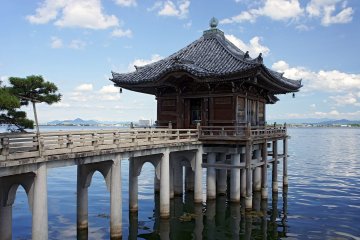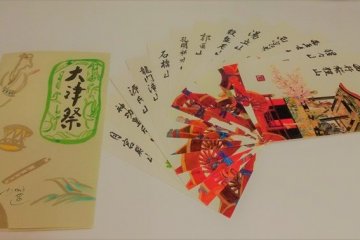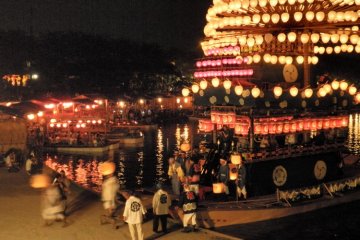Every steaming hot summer evening for over 500 years, the people of Tsushima in Aichi Prefecture go down to the Tenno river. It’s not that the river side is cooler on the evening of the fourth Saturday of July, but that’s when one of the three major river festivals in Japan, the nationally famous Tsushima Tenno Festival takes place. The Tenno Festival was said to have been a favorite of local war-lord Oda Nobunaga, and today has been designated a Nationally Intangible Folk Cultural Asset.
Tsushima is a small city of around 66,000 people, just west of Nagoya City. Apart from the Tenno Festival, Tsushimas’ Autumn Festival and Wisteria Festivals which also share a long history and traditions, Tsushima’s other claim to fame is the little known fact that there are more temples in Tsushima than there are in Kyoto!
However, it’s that fourth Saturday evening in July, the night of the “Yoimatsuri”, the Night Festival, and the celebrations that continue the next day with the “Asamatsuri”, or Morning Festival that has every one Tsushima bound.
The festival begins after sunset on the Saturday night. Various displays of matchlock gun firing and a kind of hand held fireworks resembling an upright bazooka get the festival goers in the mood. Singing and dancing also takes place before the highlight of this particular festival takes to the water. Five large and graceful Makiwara boats, consisting of two boats strapped together with purified straw ropes and decorated with over 400 large paper lanterns each, arranged in a dome like flying saucer shape, but supposed to represent a mountain, glide along the river, to the accompaniment of Tsushima flute players on board. The reflections of the hundreds of lanterns in the dark, calm waters adds to the ethereal effect.
The five boats represent the former five villages that made up Tsushima. The dome shaped arrangement of 365 lanterns, one for each of the days in the year, features a further 12 or 13 lanterns in an antennae like fashion above it. Under the orange-yellow dome of lanterns are 30 red lanterns. More lanterns decorate the bow of this floating festival float.
Most folks dressed in light summer kimono called Yukata watch from the riverside, others take to small boats to enjoy a meal, drinks and entertainments. All the while, cameras click as the lantern laiden boats sail by, and fantastic fireworks roar like thunder in the sky above.
The next morning, the same five Makiwara boats are redecorated with gorgeous red, black and gold hand woven tapestries and Karakuri Ningyo mechanical dolls dressed in Noh costumes. These boats are joined by a sixth, the “Ichieguruma” from neighboring Higashiho-Cho. This boat too is decorated with dolls representing characters from Japan’s traditional Noh performing arts. Also on board are ten men, armed with cloth covered halberds and specially chosen to take part in the ritual, where they dive off the boat with the halberd, before swimming, or walking to shore before presenting the broad bladed pole-arm to the Tsushima Shrine. The rest of the day is filled with various displays, events and festivities.
If you find yourself in Japan in late July, make sure you visit Tsushima for both days of one of Japan’s biggest and most spectacular festivals, the Tsushima Tenno Matsuri. It’s an awe inspiring sight on a hot summers’ night!













